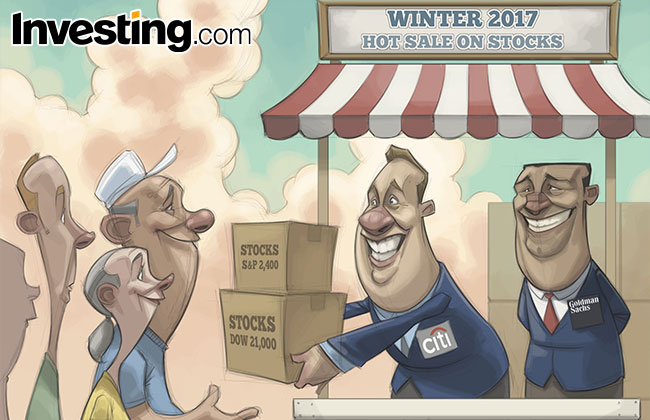[h=1]How A Major Bank "Calculated" That 20x P/E Is Now "Fair Value"[/h]
Carbon-based traders of a certain vintage - which excludes today's 20-year-old hedge fund managers - may recall a time when a 15x P/E was considered "fair." Not any more. In fact, according to a new analysis by Barclays' equity strategist Keith Parker, which tries to factor in so-called "animal spirits" as a driver of valuation has found that 20x P/E is perfectly normal and fair for the current market, further demonstrating just how deep into the goalseeking rabbit hole US capital markets have fallen.
First, to prove we are not joking, here is Barclays explaining why it is important to quantify animal spirits as a input factor of "permanently high plateaued" P/E multiples:
Core drivers of the P/E multiple and animal spirit indicators
In order to estimate the effects of “animal spirits”, or the potential effects of some of President Trump’s agenda, we first model the S&P 500 P/E using the core fundamental drivers of equity valuations. We then compare the residual from the model (actual minus fitted P/E) to various indicators of “animal spirits” or potential policy changes, including: tax policy, credit spreads, inflation, macro volatility, long-term growth expectations and corporate/consumer sentiment data.
Rates, growth and payouts are the core drivers of the P/E. Using a dividend discount framework, an equity price is the present value of future dividends. Dividing both sides of the equation by earnings, the P/E multiple is equal to the dividend payout ratio divided by the cost of capital minus the growth rate. Accordingly, the US 10y yield, US real GDP yoy and the dividend payout ratio explain 57% of the movement in the S&P 500 trailing P/E multiple from 1955 to 1997. We use the 1955-97 sample period because confiscatory tax policies prior to 1955 distorted returns to equity holders (excess profit taxes, etc), and thus affected valuations, while the 1998-2001 tech bubble would also distort results.
Other “animal spirits” indicators also affect the P/E, even controlling for the core drivers. Including the US 10y, real GDP and dividend payout ratio variables in each regression, we assess the statistical significance of other variables as it relates to the S&P 500 P/E.
The punchline: "Based on our findings we incrementally add other variables to build a more comprehensive P/E model, to better evaluate the potential effects of “animal spirits” on equity valuations"
At this point Barclays provides numerous pages of tortured, goalseek "empirical evidence" to extract the result it is after. What it "finds" is that what was once a "fair" 15x P/E is now really 20x P/E thanks to, drumroll, animal spirits.
Post-election rally closed the valuation gap with the P/E now near “fair”. The current fitted S&P 500 trailing P/E of 19.6x reflects the historical average of 15.2x adjusted for lower rates (+3x), lower dividend taxes (+2x), slightly higher analyst long-term EPS growth (1.4x), lower macro vol (+0.5x), lower dividend payout ratios (-2.6x) and the net of credit spreads and growth (+0.3x). Accordingly, the current P/E of 19.4x, although high by historical standards, is far from pricing excessive optimism, based on our model.
Here is Barclays' rationalization:
It is difficult to discern how the fundamental drivers are impacting equity valuations using current values, let alone trying to assess the potential ramifications of policy changes. As a starting point, we lay out how the variables in our model are affecting the fitted P/E relative to the historical average (Figure 14).
By separating out the drivers of the multiple, we are then better able to assess how policy changes may impact each variable and thus the P/E. The historical average trailing P/E is 15x.
- The US 10y yield at ~2.5% is much lower than the in sample average of 7%, which leads to a fitted P/E of 18x, all else equal.
- Lower dividend taxes than the historical average adds another 2x.
- Long-term EPS growth expectations using IBES data are now ~40bp above the historical average, which adds another 1.4x.
- Earnings flat-lined since 2014 and EPS moved slightly below trend, which adds 0.5x to the trailing P/E.
- Finally, inflation and IP volatility have been below historical averages, which adds another 0.5x.
On the negative side, dividend payout ratios are much lower than the historical average, which in turn reduces the fitted P/E by 2.6x. Real GDP growth is below average and is a 0.2x offset to the fitted P/E value. Lastly, credit spreads are near the historical average.
Overall, the current fitted P/E is 19.6x based on the macro drivers of the multiple, compared to 19.4x for the actual P/E using broker adjusted earnings.
 And that, ladies and gentlemen is how sellside analysts use "animal spirits" to explain that a market which is valued 33% higher than historical average, is really "fairly valued."
And that, ladies and gentlemen is how sellside analysts use "animal spirits" to explain that a market which is valued 33% higher than historical average, is really "fairly valued."











